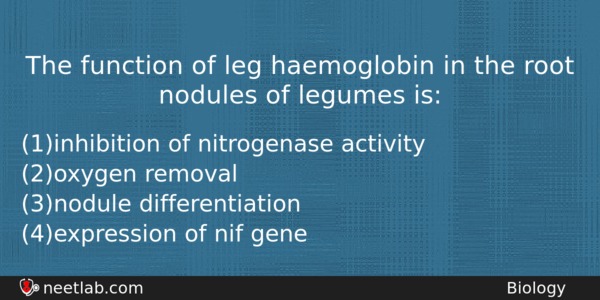| ⇦ | 
| ⇨ |
The function of leg haemoglobin in the root nodules of legumes is:
Options
(a) inhibition of nitrogenase activity
(b) oxygen removal
(c) nodule differentiation
(d) expression of nif gene
Correct Answer:
oxygen removal
Explanation:
Leghaemoglobin is the haemoglonin like red pigments found in root nodules of legumes and reported to function as an oxygen-carrying pigment in symbiotic nitrogen fixation.
Related Questions: - Hepatic portal system connects
- The primary acceptor, during carbon dioxide fixation in C₃ plants is
- Endosperm may completely be consumed by the developing embryo before the seed
- Energy currency (reservoir) of the cells is
- Respiratory quotient (R.Q.), during early stages of germination of castor seed, is
Question Type: Memory
(964)
Difficulty Level: Easy
(1008)
Topics: Plant Physiology
(28)
Subject: Biology
(4253)
Important MCQs Based on Medical Entrance Examinations To Improve Your NEET Score
- Hepatic portal system connects
- The primary acceptor, during carbon dioxide fixation in C₃ plants is
- Endosperm may completely be consumed by the developing embryo before the seed
- Energy currency (reservoir) of the cells is
- Respiratory quotient (R.Q.), during early stages of germination of castor seed, is
Question Type: Memory (964)
Difficulty Level: Easy (1008)
Topics: Plant Physiology (28)
Subject: Biology (4253)
Important MCQs Based on Medical Entrance Examinations To Improve Your NEET Score
18000+ students are using NEETLab to improve their score. What about you?
Solve Previous Year MCQs, Mock Tests, Topicwise Practice Tests, Identify Weak Topics, Formula Flash cards and much more is available in NEETLab Android App to improve your NEET score.
Share this page with your friends

Leave a Reply